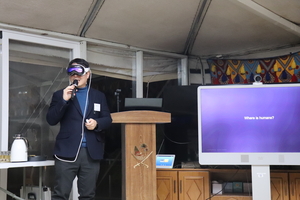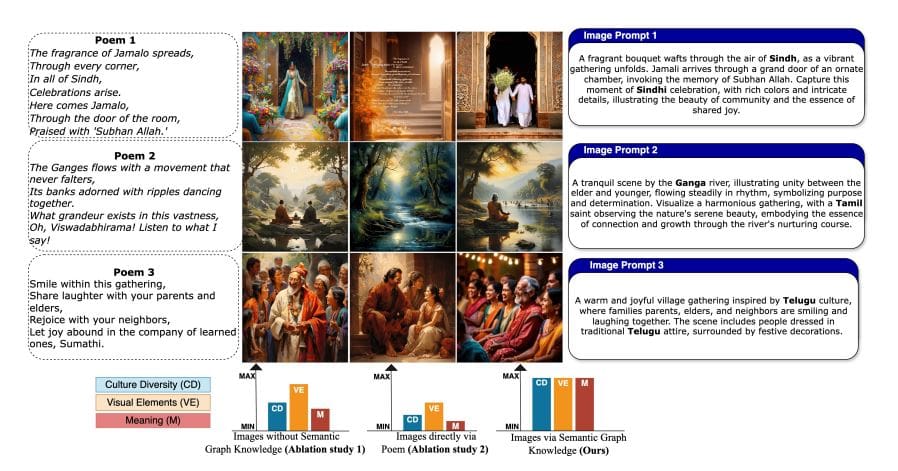Researchers from the Indian Institute of Technology Patna, including Sofia Jamil, Kotla Sai Charan, and Sriparna Saha, alongside Koustava Goswami from Adobe Research and Joseph K J, have developed a pioneering framework aimed at enhancing global access to Indian poetry. This initiative, titled the Translation and Image Generation (TAI) framework, addresses the complexities of translating Indian poetry, which is rich in cultural and linguistic nuances. By integrating translation with image generation, the researchers aim to make this literary form more accessible to a wider audience.
Innovative Framework for Cultural Bridging
The TAI framework enhances accessibility by leveraging advanced technology, including a newly created dataset, the MorphoVerse, which comprises 1,570 poems from 21 diverse Indian languages. This dataset addresses the scarcity of resources available for low-resource poetry translation. The data collection was meticulously conducted by a team of undergraduate students who ensured the authenticity of the poems sourced online and implemented rigorous data-cleaning processes for consistency.
The TAI framework operates through a three-stage process: translation, semantic graph construction, and image prompt creation. The translation module utilizes large language models to convert Indian poems into English, aiming to preserve the essence and intricate features of the original texts. Following this, a semantic graph captures essential tokens, dependencies, and metaphorical relationships within the text, thereby providing a structured representation of the poem’s meaning.
Bridging Language and Visual Art
A significant challenge in this research is the generation of images that encapsulate both the semantic meaning and the aesthetic qualities of poetry. The researchers employ diffusion models and large language models to refine the poetry text into effective prompts for image generation. Techniques such as prompt tuning and preference learning are key to aligning the generated images with human aesthetic preferences. Additionally, the innovative use of tools like Stable Diffusion, Mistral 7B, and Dreambooth enhances the generation of visually compelling representations.
By grounding the diffusion model with information generated from language models and employing multimodal approaches, the research aims to produce images that not only look appealing but also accurately reflect the emotional tone and thematic depth of the poems. Techniques such as ImageReward and RealignDiff contribute to the refinement of this process, ensuring that the generated visuals are both meaningful and culturally sensitive.
Impact on Global Education and Inequality
This initiative is aligned with the United Nations’ Sustainable Development Goals, particularly in fostering quality education and reducing inequalities. By making culturally significant poetry accessible to a global audience, the TAI framework not only advances the field of computational linguistics but also promotes a deeper understanding and appreciation of Indian literary traditions.
In summary, the TAI framework is a groundbreaking endeavor that marries technology with art, effectively bridging linguistic and cultural gaps. The innovative use of the MorphoVerse dataset and advanced AI techniques underlines its commitment to enhancing accessibility to rich literary heritage, paving the way for further research and cultural appreciation.
👉 More information
🗞Crossing Borders: A Multimodal Challenge for Indian Poetry Translation and Image Generation
🧠 ArXiv: https://arxiv.org/abs/2511.13689
 Google CEO Urges Caution on AI Trustworthiness as Gemini 3.0 Launches
Google CEO Urges Caution on AI Trustworthiness as Gemini 3.0 Launches Generative AI Transforms QA with Human Oversight to Prevent Technical Debt
Generative AI Transforms QA with Human Oversight to Prevent Technical Debt Google Launches Gemini 3 with Autonomous Agents and Veo Video Generation Tools
Google Launches Gemini 3 with Autonomous Agents and Veo Video Generation Tools Apple Unveils On-Device LLMs for Accurate Audio-Motion Activity Insights with 90% Accuracy
Apple Unveils On-Device LLMs for Accurate Audio-Motion Activity Insights with 90% Accuracy Trump Reveals AI-Generated Video with Ronaldo, Sparking Debate on Digital Authenticity
Trump Reveals AI-Generated Video with Ronaldo, Sparking Debate on Digital Authenticity






























































